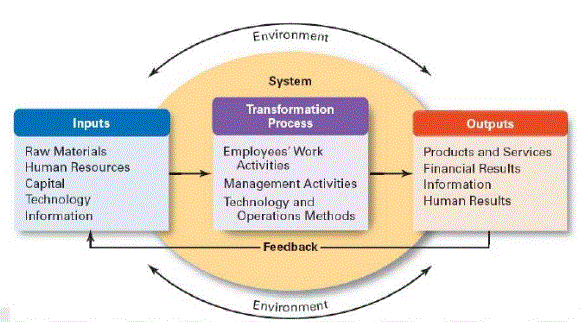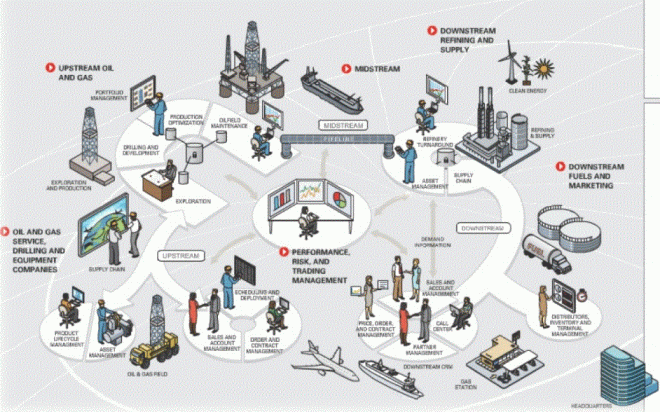A system consists of interconnected set of elements (sub-systems) that are coherently organized and work in coordination with each other to achieve a desired goal or overall objectives of the whole. These elements derive their strength by means of association and influence with other elements whereby collective contribution of the system is greater aggregate individual elements: this is known as systemic synergy. Cybernetics recognizes that a ‘whole’ system exhibits emergent properties that are not found in its parts.
A system when examined, is the product of the interactions of four main aspects:
- the number of elements,
- their interactions
- their attributes
- and their degree of organization.
The number of elements refers to the number of sub-system responsible for transformation (input, transformation, and output) contained within a system. The interaction describes the richness of the connectivity between these elements. Attributes refers to individual properties of the elements that is their particular nature and features. The degree of organization is the extent to which interactions and attributes are guided by predetermined rules.
From a system perspective; complexity is the product of richness in the connections between components of a system.
Understanding complexity implies understanding the system; when examined complexity considers interactions of four main aspects: the number of elements, their interactions, their attributes and their degree of organization. The number of elements refers to the number of sub-system responsible for transformation (input, transformation, and output) contained in system. The interaction describes the richness of the connectivity between these elements. Attributes refers to individual properties of the elements that is their particular nature and features. The degree of organization is the extent to which interactions and attributes are guided by predetermined rules.
Self-regulation describes the ability of a system to ‘manage’ itself (feedback) towards its purpose or goals despite environmental disturbances based on ether balancing or reinforcing feedback:
- First order feedback whereby the goal is determined externally to it
- Second order feedback where system is capable of choosing between variety responses to environmental changes in order to achieve its goal
- Third order system is one that is capable of changing the goal state itself in response to feedback process determining the goal internally s opposed to externally
System behavior can either by deterministic where its behavior can be known in advance as any input to the system will generate predictable outcome. Probabilism exists where there are elements of the system whole behavior is at least partially random: where ‘most likely’ outcome of the predicted variables are uncertain. (Variety engineering)
System Effectiveness and efficiency are attained through interaction of the sub-systems in pursuit of the purpose of the system in its environment via sub-systems.

Being effective is about doing the right things, while being efficient is about doing things right are both fundamental in achieving goals related to system potential, potentiality and capability. This is only possible if there is total cohesion by all the sub-systems with respect pursuit of system purpose.
Within a system there is sub-system; Information Technology Infrastructure which acts as mechanism supporting each element responsible for realizing system objective. From a system perspective IT has a fundamental role in that:
- It impacts the function of the sub-system elements responsible for transformation
- It impacts the relationship between sub-systems
- It impacts attributes and properties of the sub-system
- It should measure variables of attributes and their goal state
- It impacts efficacy with respect to synchronization of the various system elements achieving its goals
- It provides fundamental information for decision making (governance)
Based on the role of Information Technology, it is then fundamental that it does not impose constraints, that is adaptive due to the fact that relationship between system elements and their properties are adaptive due to changing environmental conditions and that it enables efficiency by maximizing potentiality.
From a system perspective Information Technology Infrastructure (ITI) consists of combined set of hardware, software, networks, facilities, etc. (including all of the information technology store, retrieve, transmit, and manipulate data ), in order to support the various sub-system ability to realize system purpose by managing its platform, processes, devices and data.

IT management is the discipline whereby all of the information technology resources of a system are managed in accordance with its needs and priorities. These resources may include tangible investments like computer hardware, software, data, networks and data center facilities, as well as the staff who are hired to maintain them.
Enterprise Architecture is a discipline for proactively and holistically leading enterprise responses to disruptive forces by identifying and analyzing the execution of change toward desired business vision and outcomes. EA delivers value by presenting business and IT leaders with signature-ready recommendations for adjusting policies and projects to achieve target business outcomes that capitalize on relevant business disruptions.
From a Systemic perspective ITI needs to be in total cohesion with the overall purpose and overall goals/objectives of the whole (system):
- The Information Technology Infrastructure must support the various system functions in achieving its purpose and must ensure cohesion towards total system purpose and goals
- The ITI sub-system must be an enabler for effective viability management
- The ITI sub-systems must be enabler for leveraging optimum potentiality and capability
- The ITI sub-systems must contain effective feedback in order to optimize system processes
- The ITI sub-systems must be an abler the effective co-ordination and synchronization the sub-systems responsible for the primary transformation activities (delivery products / services ) The ITI must be able elevate conflict with respect to co-ordination various function due to constraints
- The ITI sub-systems must be able to generate alerts timeously with respect to deviations from stated goals of critical variables goal sate
- The ITI sub-systems must be adaptive: must be adaptable to changing business requirements
- The ITI sub-systems must responsive : must be able to respond to business needs timeously
- The ITI sub-systems must be flexible (rather than rigid) : must be flexible to changing system needs
- The ITI sub-system must be efficient (cost and resource perspective)
In summary the ITI sub-system must be managed so that it`s effective: therefore the right IT infrastructure that that is effective, adaptive, responsive and efficient.
